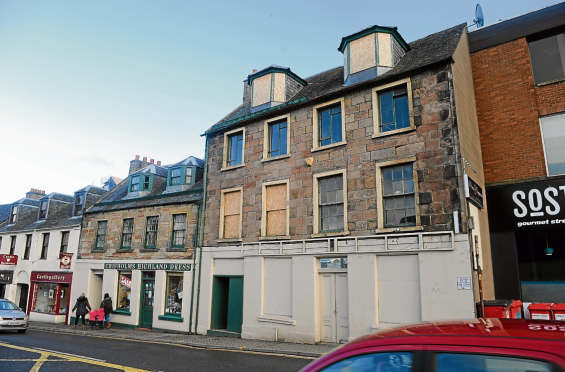Emergency work is due to start this week on a historic Inverness building after it was hit with a Dangerous Buildings Notice yesterday.
The premises on Castle Street belong to the well-known kiltmakers Duncan Chisholm & Sons Ltd, whose own business is next door.
The Highland Council will carry out the work to “avoid risk to the public”, with the owners to pay at a later date.
A spokeswoman said: “Additional work is required to remove the risk to the public from falling masonry due to the decaying roof impacting on the external walls.”
It is the second time in less than two years that the vacant premises have been issued with a Dangerous Buildings Notice.
The authority also warned pedestrians and the public about the work with possible inconvenience and diversions.
The Chairman of the Inverness Civic Trust, James Maxwell, said it is on Historic Environment Scotland’s buildings at risk register.
“It is one of the prime examples of old Inverness, the B-listed building is considered to be 18th century and is in a relatively untouched condition.”
Mr Maxwell noted that one of the problems is the lack of support offered to owners of such properties.
“There is no assistance available, a Grade-B listed building probably wouldn’t get it anyway, because up until 2016 there was VAT relief on repairs.”
One idea brought up at the Inverness Civic Trust to conserve the city’s architectural past is to use the Common Good Fund as means of support.
“An exercise should be performed to see what could be done so that 20% could be taken by the Highland Council [Common Good Fund].”
He added: “One has to be realistic but offering VAT relief on repairs would assist enormously with the cost of those repairs.”
The building is one of the surviving examples of the original architecture that used to run up both sides of Castle Street to View Place.
Inside it contains a courtyard where more than 50 families once lived and which includes a “marriage stone” dating to 1792.
It is understood that if Duncan Chisholm & Sons Ltd undertook a complete restoration themselves the costs could run into the millions.
The technical difficulties in restoring buildings hundreds of years old multiplies the costs as does complying with rules regarding alterations to listed buildings.
